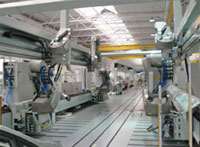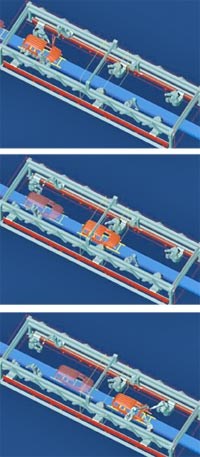Fully Automatic
'Dual Rail' technology envisions short painting lines and 100% automation through integrated application concepts.
#measurement-testing
A complete painting line, almost 30% shorter, with fully automatic paint application, highly flexible and with a capacity of more than 50 units per hour?
Yep, it's a reality. According to Dürr Systems, Inc. (Auburn Hills, MI) such a line will be put into operation this year.
Featured Content
Short painting lines save money on two counts: investment and operating costs. Dürr's new solvent-based, 3-wet process is all about full automation (exterior and interior robot paint application) offering the possibility of short painting lines, high transfer efficiency, minimum color change losses, consistent quality and reduced energy demand.
Typically, robots are accompanied by fail-safe protection—backup zones with manual applicators—adding length to the line as well as potential quality problems.
Another way to compensate for a robot down is to reassign the painting scopes in the affected station to the remaining robots, a strategy called "degrade." System capacity needs to be considered for this strategy, though. If a temporary reduction of the system capacity is acceptable, a line can manage with the number of robots required for optimum output. But if that's not the case, redundancy has to be built into the robot station.
The degrade concept has become state-of-the-art in exterior application. In interior application, however, the connections are more complex. In interior painting, not only are painting robots used, but also robots for handling and opening and closing doors and hoods. In standard interior painting setups with only one traveling rail per side, handling robots share the rail with painting robots—so they can't be used for various jobs.
According to Dürr, this inflexible situation with its related disadvantages is solved by the company's "dual rail" technology. The setup consists of a robot cell with two traveling rails per each side, laid out above one another with painting robots on the lower rail, and handling robots on the upper one. This way, they can act completely independent of each other, and a mutual overtaking is now possible, filling an important requisite for degrade mode.
Dürr says that an important feature of its Ecopaint robot concept is high flexibility of the overall system, another essential factor for degrade. Thus, a hood opener can also open doors and a painting robot can replace handling robots. And the local separation of painting and handling leads to a shortening of the station length.
With this setup, says Dürr, the degrade challenges are fundamentally solved, and backup zones can be eliminated. When the interior and exterior stations are considered together, however, there are still too many robots, creating redundancy. Combining the interior and exterior application (in other words: a robot of the interior station would become an all-rounder) would allow the exterior station to be laid out optimally without redundancy. The all-rounder robot could paint interior and exterior and open doors and hoods.
Traditionally, says Dürr, the problem with this concept is that atomizers typically couldn't be used equally well for interior and exterior surfaces—and with both narrow and wide paint patterns—while still maintaining high transfer efficiency and finish appearance quality.
The company's answer to this is its EcoBell2 HX, a merger of its EcoBell2 for exterior painting and EcoBell2 HD for interior application—an atomizer for all cases.
The company has big dreams for its all-case atomizer. With few exceptions, most painting lines worldwide are designed as line concepts, with one application step following another. This linear process, says Dürr, has been necessitated by the differing applicators for the individual paint applications. Pneumatic atomizers for interior painting, bells for the first base coat application, pneumatic atomizers again for the second base coat application. But these sequential steps may no longer be necessary with the EcoBell2 HX, Dürr says.
Modular or integrated concepts, where a vehicle is painted completely, inside and out, in one station, would be conceivable. The advantages of such a system are clear: maximum painting time relative to total cycle time, reduction of color change loss, and high flexibility concerning the total system capacity are a few. By switching individual modules on or off, it's foreseeable that such a system would make it possible to react to market demands considerably faster than is the case today.
RELATED CONTENT
-
Supercar Gets Super Ecoat System
Honda builds unique ecoat system for Acura NSX at $70 million Performance Manufacturing Center.
-
Plating Thickness Pitfalls and Measuring Instruments
Proper coating thickness is crucial in both functional and decorative plating. Here are some common problems and ways to measure coating thickness.
-
Coating Thickness Measurement: The Fundamentals
A review of available test methods, common applications and innovative instrumentation...





















